A Global Approach to HPLC Column Selection Using Reversed Phase and HILIC Modes: What to Try When C18 Doesn't Work
LCGC North America
Experimental data are presented to help understand HPLC column retention in a way that should make column selection and method development proceed faster when initial results with C18 columns are disappointing.
Aqueous–organic mobile phases (for example, water–acetonitrile) have become preferred for high performance liquid chromatography (HPLC) analysis due to their wide availability, high quality, low toxicity, and compatibility with popular detection methods. Selecting the optimum column to work with aqueous mobile phases is an important part of HPLC method development. Given the vast number of choices and the lack of chemical detail about many column products, many analysts do not take time to explore column options in any systematic way. Most prefer to simply use familiar columns having traditional C18 or closely related phases. Published column selection guides and other resources are available; however, they tend to be biased toward specific products or involve mathematical treatments that can be too complex and time-consuming for the busy analyst.
Recommendations for column selection have appeared in the literature and virtually every LC textbook. Early column selection schemes were uncomplicated, because there were relatively few column choices. However, as the number of columns and separations has grown, it has become difficult to organize the information for use in developing new methods. Historically, HPLC applications have highlighted success stories for individual columns. If one has different compounds, success depends upon the similarity of the analyte to the compounds in the published application. If one could not acquire the same column or preferred to evaluate another brand, information about the relative behavior of different column phases toward the analyte would be needed, but is seldom available. Classification schemes are sometimes helpful but often are focused on the characteristics of the stationary phase (for example, polar, nonpolar, deactivated, and so forth) rather than the behavior of target analytes. For example, while nonpolar solutes are separated readily on reversed-phase columns, water-soluble analytes can benefit from consideration of a separation mode such as hydrophilic interaction liquid chromatography (HILIC), which also is referred to as aqueous normal phase (ANP). This article will employ the name HILIC/ANP for this mode, which is growing in popularity because it is complementary to the reversed-phase mode.
A global approach to predicting retention patterns has been developed around three highly orthogonal phases. C18, silica, and pentafluorophenylpropyl (PFP or F5) have very different surface polarity and are compatible with popular aqueous-organic mobile phases. C18 and silica columns were obvious selections as the boundary conditions for global screening, while PFP was selected as a good column example that exhibits strong retention in both reversed-phase and HILIC/ANP modes. Test compounds were selected to illustrate a wide range of chemical properties, including neutral, acidic, basic, and zwitterionic functional groups. When this column screening method is applied to any target mixture, results should indicate whether reversed-phase, HILIC/ANP, or both modes can be useful.
By systematically varying organic-water content, pH, and ionic strength, it becomes possible to draw useful conclusions about retention patterns on very different phases for a wide range of compound polarities. This more global approach allows one to determine where a particular stationary phase–analyte combination is likely to be successful, or, conversely, where a particular combination is unlikely to produce useful chromatographic results.
Experimental
Reagents and Chemicals: Test probes were obtained from Sigma-Aldrich (St. Louis, Missouri) and were reagent grade or better. Acetonitrile for mobile phase use was HPLC grade (Acros Chemicals, Geel, Belgium). Water was produced by a local purification system (Culligan Water Systems). Mobile phase additives (ammonium formate and trifluoroacetic acid) were reagent grade and obtained from Sigma-Aldrich. Standards were dissolved in 50% buffer–acetonitrile at a concentration of approximately 20 mg/mL. This 50:50 blend is not always ideal for evaluating retention and peak shape under both reversed-phase (often >50% water) and HILIC/ANP (often >50% acetonitrile) mobile phases; however, one can usually avoid problems by injecting small sample volumes of 5 μL or less into standard-bore columns. During method optimization, samples should be dissolved when possible in solvents that are slightly weaker than the mobile phase for the mode selected.
Equipment: All HPLC experiments used an Agilent 1100 system (Agilent Technologies, Santa Clara, California), consisting of an on-line degasser, binary pump, autosampler, temperature-controlled column compartment, and diode- array detector with semimicro flow cell. Columns were maintained at 25 °C for all experiments. Injection volume was 5 μL. Instrument control was provided by ChemStation software (Agilent Technologies), version B.04.01.
Columns: All columns were supplied by Supelco Division of Sigma-Aldrich, Inc. (Bellefonte, Pennsylvania). The stationary phases, dimensions, and operating conditions are summarized in Table I. To maintain consistent separation conditions, column flow was adjusted to produce constant, optimum linear velocity for the particle size and column internal diameter.

Table I: Global screening columns
Procedure: Each column was equilibrated with the appropriate mobile phase for a minimum of 5 min. For the short columns used in this study, this represented a minimum of 10 column volumes. Suggestions for starting conditions during method development are discussed in the Recommendations section. The diode array collected spectra and monitored several wavelengths to allow detection and confirmation of identity for all analytes. For convenience, chromatograms are displayed at 230 nm, but this does not necessarily represent the optimum setting for each compound.
Because it can be difficult to select true void volume markers for columns and analytes under global conditions, void times were estimated from column dimensions (tM = 0.25 × e × π × dc2 × L/Fc), where e is the column porosity, dc is column diameter, L is length, and Fc is flow rate). The value of e was set at 0.64 for this study, which represented a midrange value for the column types being studied. Thus, calculated retention factors k can be different from actual measured values for some columns. However, since only relative retention factors are being compared, these differences do not affect any study conclusions. Only retention factors between 1 and 10 are reported for comparison, as values outside this range are not chromatographically useful.
Results and Discussion
Column Selection: A simplified representation of the three stationary phases is provided in Figure 1. The C18 column surface is designated as nonpolar on a global scale. With the development of very pure silica and improved bonding techniques, modern C18 columns have become more consistent and reproducible, allowing many different column brands to be used interchangeably with this global screening procedure. However, note that older C18 columns and those designed for use in high aqueous mobile phase can show more retention for polar solutes than the phase used in this study. Most method development activities start with a C18 column and only examine other options if adequate retention or separation cannot be obtained. Retention patterns often show reversed-phase trends, where retention increases with decreasing acetonitrile content, meaning that acetonitrile is a "strong" eluent. Retention is related to the number of carbons in the analyte, with more carbon character producing more retention when other functional groups are similar. When little retention is observed on a C18 phase, the sample is too polar and orthogonal columns must be considered.

Figure 1: Chemical structure of stationary phases: (a) C18, (b) silica, and (c) PFP.
Silica columns are designated highly polar on a global scale and have been used increasingly with aqueous–organic mobile phases in a HILIC/ANP mode, which resembles reversed-phase mobile phase conditions. This mode offers an attractive separation technique for highly polar, water-soluble analytes that is orthogonal to any reversed-phase column, easily separating compounds that have low retention in reversed-phase systems. Retention patterns typically show normal phase trends, where retention increases with decreasing water content, meaning that water has become the "strong" eluent. Many modern silica columns should show similar results if substituted for the brand used in this global screening procedure.
Fluorinated aromatic columns, with PFP phases, are difficult to classify accurately on a global polarity scale, but they are convenient to place between C18 and silica, since they show some retention characteristics of both C18 and silica (1–4). The phenyl ring adds aromatic character to the surface, but the electronegative fluorines tend to withdraw electron density, resulting in a ring system that is very electron deficient. PFP behaves as a strong Lewis acid by attracting compounds that can act as Lewis bases by donating electrons (that is, amines). In addition to forming π-π complexes, PFP phases can retain solutes by dipolar and H-bonding forces at the very polar C–F bonds. While strong π-π interactions and significant carbon character make PFP columns attractive for aromatic and hydrophobic molecules in the reversed-phase mode, retention also seems to occur by polar interactions in the HILIC/ANP mode. With a rigid ring system and so many ways to interact with solutes, it is not surprising that PFP also exhibits good shape selectivity. PFP columns show orthogonal behavior compared to C18 in most cases (5,6), but are also orthogonal to silica in some cases. Columns such as PFP, with both nonpolar and polar character, have a split personality and can show dual-mode behavior. They produce a "U-shaped" retention pattern as a function of acetonitrile content, with retention increasing at both low and high concentrations of acetonitrile. While different PFP columns should show good interchangeability in this global screening scheme, other aromatic columns with phenyl or naphthyl phases may not produce the same HILIC/ANP trends.
Test Probe Selection: We have selected representative test probes from four broad classes of organic molecules: neutral, acidic, basic, and zwitterionic. Although the probes covered a range of size and polarity, many were more polar and water soluble, as such compounds are generally more difficult to separate on traditional reversed-phase media. Clearly, it is not possible to model all acids or bases using only a few probes for each class, but only to identify general trends from which the analyst can infer behavior for other analytes or actually test behavior for their particular sample using global screening. This approach allows selection of the column system and mode that is most likely to be successful when difficult separations are encountered.
Mobile Phase Selection: Retention was followed under isocratic conditions as a function of acetonitrile content, in increments from 10% to 90%, to establish conditions where column retention occurs. Control of aqueous pH was also included, as this can have a significant impact on retention in aqueous–organic mobile phases. The pH was adjusted to acidic conditions (pH = 2–3) by addition of trifluoroacetic acid at either 0.1% or 0.02% (v/v). Trifluoroacetic acid was chosen, but other acids such as phosphoric, sulfuric, and formic usually produce similar trends, unless significant ion-pairing occurs between additive and solute (7). Neutral conditions were obtained by dilution of an ammonium formate concentrate to 50 mM and 10 mM levels. This near-neutral pH was chosen to represent the pH 7–8 range. A pH range is reported due to the uncertainty in knowing true pH under changing organic conditions. Solubility and volatility characteristics can make trifluoroacetic acid and ammonium formate attractive alternatives to the more traditional inorganic buffering systems. Finally, changing additive concentration allowed a qualitative assessment of the impact of ionic strength and ionic processes on retention.
Retention Patterns on C18: Figure 2 provides a summary of retention effects on the C18 phase. Results highlight the expected behavior for this phase, which is retention of neutral compounds based upon carbon content or hydrophobicity, without pH sensitivity. The two phthalates and toluene show a significant increase in retention as the acetonitrile content decreases. Acids are retained only under acidic conditions, where the analytes are in their neutral form, and only if the acid has significant hydrophobicity (for example, benzoic acid). Also, because these acids are polar and water soluble, significant retention only occurs when the acetonitrile content is much lower (that is, less than 30%). The polar and weakly basic creatinine demonstrated no C18 retention under acidic conditions. Protriptyline shows considerable retention because the extra carbons provide net hydrophobic character, even though the molecule has positive charge under acidic conditions. The less hydrophobic procainamide demonstrates little retention under positively charged conditions. The zwitterions are not retained under acidic conditions.
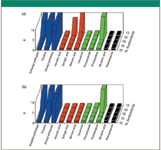
Figure 2: Retention effects on C18: (a) Acidic mobile phase (0.1% trifluoroacetic acid), (b) neutral mobile phase (50 mM ammonium formate). The plots show retention factors for each test probe over an acetonitrile range of 10% to 90%. Only retention factors between 1.0 and 10 are plotted. The test probes are grouped by chemical class and color coded: neutrals = blue, acids = red, bases = green, zwitterions = black.
At neutral pH, only the neutral compounds and more hydrophobic protriptyline showed significant retention. Many bases would show retention under these conditions, but the basic compounds in this study are too polar to be retained significantly. The acids and zwitterions are polar and ionized, resulting in no retention. Changing the concentration of buffer–additive did not affect compound retention on C18 at either high or low pH.
These results identify some important limitations of C18 phases. While retention of most neutral molecules and hydrophobic acids and bases is relatively easy, very polar analytes often show little retention even under highly aqueous conditions. An orthogonal phase clearly is required to produce retention with aqueous–organic mobile phases for the latter groups of compounds.
Retention Effects on Silica: Under acidic conditions, silica was essentially nonretentive to all analytes, as shown in Figure 3. Although some actual retention was observed, retention factors were less than one, thus offering no potential for effective separation. It is important to note that the neutral compounds are not retained, thus highlighting the orthogonality of this phase compared to C18.
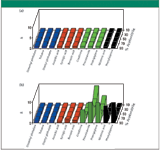
Figure 3: Retention effects on silica: (a) acidic mobile phase (0.1% trifluoroacetic acid), (b) neutral mobile phase (10 mM ammonium formate).
At neutral pH, where silica takes on a partial negative charge, neutral test compounds still were not retained to any significant extent, and acid retention factors exceeded one only when the acetonitrile content was greater than 80%. Bases, however, showed a dual retention mechanism pattern, with a significant increase in retention at both high (HILIC/ANP mode) and low acetonitrile percentage. Protriptyline, the larger, more hydrophobic base, was eluted before the smaller, less hydrophobic procainamide, indicating a "normal phase" retention pattern in terms of carbon structure. Examples of increasing retention on silica with decreasing acetonitrile have been previously reported (8), especially for ionic compounds, but the reason for retention is often unclear.
Figure 4 shows a U-shaped curve for bases on silica at neutral pH. Although retention increases at both extremes of the curve, the region of high acetonitrile concentration is of special interest because the operating pressure is lower and sensitivity is enhanced for electrospray MS detection. Increased retention with increased organic solvent is well known in the HILIC/ANP mode.

Figure 4: Retention patterns for bases on silica at neutral pH with varying additive concentrations.
The silica data also illustrate an additional contribution to retention that often is not recognized. When the ammonium formate decreases in concentration from 50 mM to 10 mM, the retention factors for protriptyline increase by a factor of two or more. At neutral pH, the surface of silica is expected to have partial negative character, and strong bases still should exist as cations. Electrostatic attraction might be contributing to retention, which would explain why retention is affected by salt concentration at all acetonitrile levels. Procainamide is affected in a similar manner. Creatinine is sensitive to acetonitrile but not sensitive to salt concentration because it is not charged at neutral pH. Zwitterions show retention only in the HILIC/ANP region.
Retention Effects on PFP: PFP showed more versatile retention characteristics than either C18 or silica (Figure 5). Under acidic conditions, neutral organics were retained and separated by a traditional reversed-phase mechanism. Acids also were more retained by a reversed-phase mechanism under acidic conditions, but only at somewhat low acetonitrile concentrations, like the C18 phase. Bases and zwitterions showed U-shaped retention patterns, indicating a dual-mode retention of HILIC/ANP at high organic and reversed phase at low organic, and also were sensitive to acid concentration, with an increase in acid concentration causing a decrease in retention.
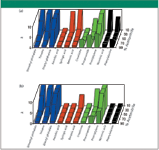
Figure 5: Retention effects on PFP: (a) acidic mobile phase (0.1% trifluoroacetic acid), (b) neutral mobile phase (50 mM ammonium formate).
At neutral pH, retention of neutral organic compounds was unaffected as expected, and retention of polar acids decreased significantly, also as expected. Only benzoic acid showed any significant retention at neutral pH. Similarly, zwitterions and creatinine were not retained, but the more hydrophobic bases were retained strongly and retention was influenced strongly by salt concentration, as it was for the silica column. Retention factors for the larger, more hydrophobic protriptyline molecule were never less than five on PFP under neutral conditions. Such results are expected, because electron-rich bases should be strongly attracted to the electron-deficient PFP ring on the stationary phase.
Figure 6 shows the variety of retention trends present on PFP. Crossing lines indicate a change in selectivity as a function of acetonitrile concentration. Thus, both retention and selectivity can be changed by adjusting acetonitrile content and acid modifier concentration. Similar trends were observed under neutral conditions.
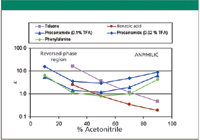
Figure 6: Retention effects on PFP with an acidic mobile phase. Procainamide retention data are displayed for different acid concentrations.
Conclusions and Recommendations
A simple column-screening approach has been shown that can be used to provide valuable retention data for any column–analyte combination. By surveying retention over a significant range of aqueous–acetonitrile concentrations (10%–90% in this case), and also checking retention at different additive–buffer concentrations, retention profiles can be obtained and used for more rapid column selection and optimization. Different buffers and additives can be substituted for trifluoracetic acid and ammonium formate, but the general trends should not change.
Table II summarizes the trends observed for this particular global study, which featured small molecules and included some highly water-soluble compounds. Successful results will be obtained sooner when general retention patterns like this are known in advance for different columns, which can lead to a more guided approach to mobile phase selection. For example, choosing a C18 phase to separate polar acids, polar bases, or zwitterions is not as likely to produce successful retention as choosing a more orthogonal phase. Similarly, choosing silica to separate neutral molecules is not as likely to produce successful retention as choosing C18 or PFP when an aqueous–organic mobile phase is desirable.
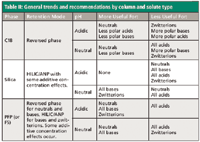
Table II: General trends and recommendations by column and solute type
Table III summarizes general recommendations for each compound class that have been derived from the global study and results summarized in Table II. With six different combinations to choose from (three phases and two pH values), it is possible to identify at least two promising separation options for each compound class.
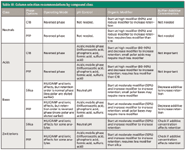
Table III: Column selection recommendations by compound class
These options are illustrated in Figure 7 for the bases. Suitable retention is observed using either silica with 80% acetonitrile and 50 mM ammonium formate, or PFP with 75% acetonitrile and 0.1% trifluoroacetic acid. While both phases show HILIC/ANP behavior, the retention order is different for the two phases. These conditions would be appropriate for bases that are highly retained. More polar bases can show less retention and require either increased acetonitrile concentration or reduced additive concentration, or both.
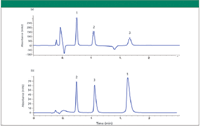
Figure 7: Separation of bases using higher concentration modifiers. Top: silica, 80:20 acetonitrileâ50 mM ammonium formate. Bottom: PFP, 75:25 acetonitrileâ0.1 % trifluoroacetic acid. 1 = PRT (protriptyline), 2 = CRT (creatinine), 3 = PRC (procainamide).
Finally, it is important to remember that different sample preparation procedures are required for the different operating modes shown here. Ideally, samples should be dissolved in the isocratic mobile phase for best peak shape. When this is not possible, samples should be prepared in the "weakest" solution that still provides adequate sample solubility. For reversed-phase methods, this means adding more water, and avoiding 100% acetonitrile. For HILIC/ANP methods, the sample solvent should contain as much acetonitrile as possible, while avoiding predominantly aqueous solutions.
This article has focused on column screening to produce retention for classes of analytes under two orthogonal modes. Further studies will explore behavior of other column types and how these retention trends can be exploited to separate analytes of different classes from each other.
Merlin K. L. Bicking* and Richard A. Henry†
*ACCTA, Inc., St. Paul, Minnesota
†Consultant, State College, Pennsylvania
Direct correspondence to: mbicking@accta.com.
References
(1) M. Przybyciel, LCGC 23(6), 554–565 (2005).
(2) D.S. Bell and A.D. Jones, J. Chromatogr., A 1073, 99–109 (2005).
(3) D.S. Bell, H.M. Cramer, and A.D. Jones, J. Chromatogr., A 1095, 113–118 (2005).
(4) D.H. Marchand, K. Croes, J.W. Dolan, L.R. Snyder, R.A. Henry, K.M.R. Kallury, S. Waite, and P.W. Carr, J. Chromatogr., A 1062, 65–78 (2005).
(5) M.K.L. Bicking and R.A. Henry, "HPLC Retention Effects for Cationic Analytes on PFPP Stationary Phases in Dilute Acid Mobile Phases," Abstract No. 830-1P, Pittcon 2008, New Orleans, Louisiana.
(6) M.K.L. Bicking, "Tuning Selectivity to Improve Separations on PFPP Stationary Phases," Abstract No. 2730-17, Pittcon 2009, Chicago, Illinois.
(7) J. Dai and P.W. Carr, J. Chromatogr., A 1072, 169–184 (2005).
(8) B.A. Bidlingmeyer and J. Henderson, J. Chromatogr., A 1060 187–193 (2004).
Acknowledgment
The authors would like to acknowledge Supelco Division of Sigma-Aldrich, who provided the columns for use in this study, and Aveka, Inc. (St Paul, Minnesota), who provided equipment and facilities.
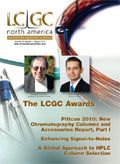
Common Challenges in Nitrosamine Analysis: An LCGC International Peer Exchange
April 15th 2025A recent roundtable discussion featuring Aloka Srinivasan of Raaha, Mayank Bhanti of the United States Pharmacopeia (USP), and Amber Burch of Purisys discussed the challenges surrounding nitrosamine analysis in pharmaceuticals.
Extracting Estrogenic Hormones Using Rotating Disk and Modified Clays
April 14th 2025University of Caldas and University of Chile researchers extracted estrogenic hormones from wastewater samples using rotating disk sorption extraction. After extraction, the concentrated analytes were measured using liquid chromatography coupled with photodiode array detection (HPLC-PDA).













